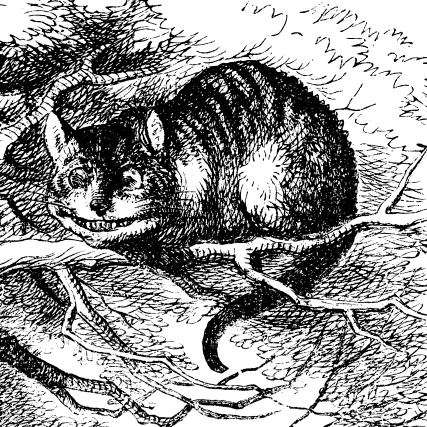Cheshire Cat in popular culture
It has been suggested that this article be merged into Cheshire Cat and Talk:Cheshire Cat#Merger proposal. (Discuss) Proposed since July 2008. |

The Cheshire Cat is one of many iconic characters from Lewis Carroll's Alice's Adventures in Wonderland that have become enmeshed in popular culture.[1] Depictions of the Cheshire Cat have appeared in many media, from political cartoons to television.[2][3] The Cheshire Cat's grin is reminiscent of the vagaries of human character or of a trickster nature.[4][5]
Prior to the release of the Walt Disney animated production Alice in Wonderland, scholars observed few specific allusions to this character. Martin Gardner, author of the The Annotated Alice, wondered if T. S. Eliot had the Cheshire Cat in mind when writing Morning at the Window but notes no other significant allusions in the pre-war period.[6]
Images of and references to the Cheshire Cat cropped up more frequently in the 1960s and 1970s, along with more frequent references to Carroll's works in general.[7] The Cheshire Cat appeared on LSD blotters as well as in song lyrics and popular fiction.[8][9] For example, in the Star Trek episode Who mourns for Adonais?, Kirk and Chekov argue over the origin of the "vanishing cat" and Chekov amusingly alleges that it came from Minsk[10].
Notes
- ^
Silvey, Anita (2002). The essential guide to children's books and their creators. Houghton Mifflin. p. 78. ISBN 0618190821.
{{cite book}}: Cite has empty unknown parameter:|coauthors=(help) - ^ Joan L. Conners, "Popular Culture in Political Cartoons: Analyzing Cartoonist Approaches," Political Science & Politics 40 (2007): 261-265.
- ^
Nobuhiro Watsuki, Hayao Miyazaki, Yuji Oniki, Michelle Pangilinan (2005). The Art of My Neighbor Totoro. ISBN 1591166985.
{{cite book}}: CS1 maint: multiple names: authors list (link) - ^
Mulderig, Gerald P. (1977). "Alice and Wonderland: Subversive Elements in the World of Victorian Children's Literature". Journal of Popular Culture. 11 (2): 320–329.
{{cite journal}}: Cite has empty unknown parameter:|coauthors=(help) - ^
Roberts, Patrick (2006-02-17). "Lewis Carroll's Cheshire Cat". Purr-n-Fur UK. Retrieved 2008-07-07.
{{cite web}}: Cite has empty unknown parameter:|coauthors=(help) - ^
Gardner, Martin (1999). The Annotated Alice: Alice's adventures in Wonderland & Through the looking glass. W.W. Norton. p. 62. ISBN 0393048470.
{{cite book}}: Cite has empty unknown parameter:|coauthors=(help) - ^ Brooker, Will (2004). Alice' s Adventures: Lewis Carroll and Alice in Popular Culture. London: Continuum. p. 81. ISBN 0-8264-1433-8. Retrieved 2008-07-07.
- ^
Vanessa St Clair (Tuesday June 5, 2001), A girl like Alice, The Guardian
{{citation}}: Check date values in:|date=(help) - ^
Real, Willi (2003). "The Use of Literary Quotations and Allusions in: Ray Bradbury, Fahrenheit 451". Retrieved 2008-07-07.
{{cite web}}: Cite has empty unknown parameter:|coauthors=(help) - ^ John Arthur Maddux. The Classic Star Trek Trivia Book. ISBN 1886420394.
References
- Brooker, Will (2004). Alice' s Adventures: Lewis Carroll and Alice in Popular Culture. London: Continuum. ISBN 0-8264-1433-8.
- Gardner, Martin (1999). The Annotated Alice: Alice's adventures in Wonderland & Through the looking glass. W.W. Norton. ISBN 0393048470.
{{cite book}}: Cite has empty unknown parameter:|coauthors=(help) - Silvey, Anita (2002). The essential guide to children's books and their creators. Houghton Mifflin. ISBN 0618190821.
{{cite book}}: Cite has empty unknown parameter:|coauthors=(help)
